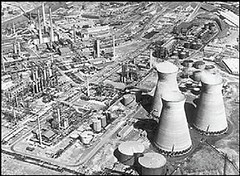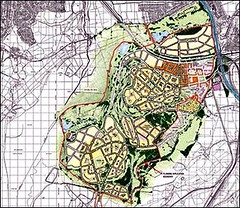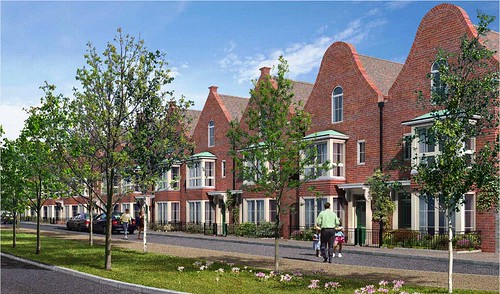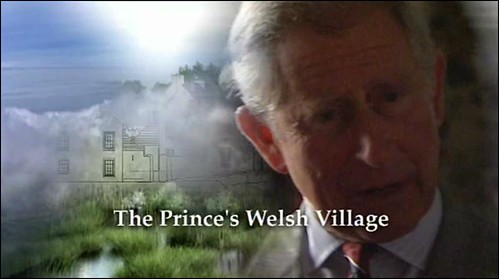HRH the Prince of Wales on building a better community — in Wales

Posted April 13, 2010 at 1:28PM
Coed Darcy Urban Village is a development-in-progress that will comprise 4000 homes, commercial space, and green space covering 1,300 acres, with an integrated land use pattern of residential and employment uses supported by a full range of community facilities and offering the opportunity to live and work in the same community. It is a project of The Prince’s Foundation for the Built Environment (full disclosure: my friend Hank Dittmar is CEO), in collaboration with oil conglomerate BP, which formerly had a refinery on the site.
I am normally not a fan of so-called “new towns,” which tend to be plopped down on farmland disconnected from but generally within long commuting range of major metro areas. They may be internally fine, but they also fragment the countryside, attract sprawl, and typically have terrible transportation characteristics. Coed Darcy is different, in my mind, because it is transforming a previously developed brownfield site – the largest of its kind in Europe – that has required major environmental cleanup. It is also adjacent to a preexisting “company town” that housed mostly refinery workers. There is no question that it will be a net improvement over what used to be there.
Here’s how the Foundation’s project summary puts it:
“At the core of the development is the village centre and the proposed public transport interchange and local rail halt. A wide range of uses is illustrated with four local centres providing focal points of activity and community facilities. The undeveloped parts of the refinery are improved with structure landscape into a public open space area for the new development, with the majority of the ecological sensitive parts of the site protected. The reservoir is removed and an ecology wetland area is established along the valley floor connecting into Crumlin bog. A network of linkages connects the development to Llandarcy village and Skewen with improved access to Llansamlet and Swansea.”
Master planning has been by Robert Adam Architects in cooperation with Edward Ware Homes.
Clarification April 16, 2010: The developer/remediator of the Coed Darcy site is St. Modwen Properties. Master planning has been done by Alan Baxter Associates, with strategic advice from The Prince's Foundation. The project is overseen by a board including the local authority (Neath Port Talbot), St Modwen and the Prince's Foundation. The first wave of homes was built by Ed Ware/Atlantic Homes; they were designed by Robert Adam Architects (now Adam Architecture).
You can download some details in the project’s design statement.
There is a great short video on the project, produced by the BBC. In addition to featuring a very articulate Prince Charles on camera, and images of the village as proposed and in progress, it also presents an architecture critic who challenges the authenticity of carefully planned communities. She’s not entirely wrong about that, but it’s not like haphazard development has been serving us well in the last few decades. Since we’re going to have development, I think we should plan it as best we can. One can also make the argument that the development is trying a bit too hard to emulate centuries-old Welsh architecture, and thus might develop a sort of "museum piece" feel. Maybe. But, over time, it will develop more organically, as properties are altered or replaced by owners, who will also present them differently with personal touches. One could do worse than to borrow from the old as a beginning.
The video is on YouTube, but embedding seems to be annoyingly disabled (what’s up with that, Hank?). So, in a sort of poor man’s version of embedding, click on the screen capture below and it will take you to the video:



